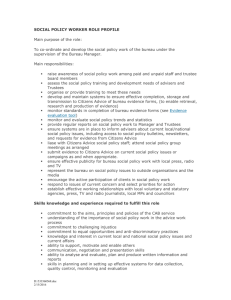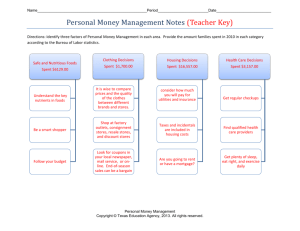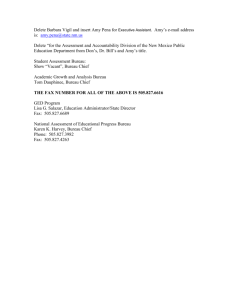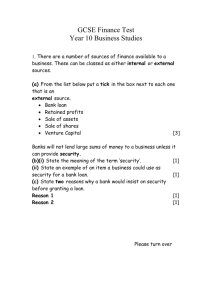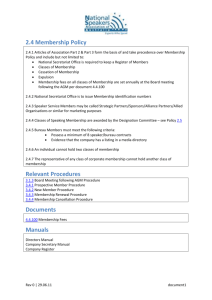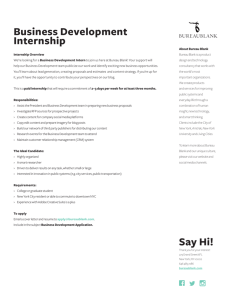Deceased Member Accounts: an eTrain Webinar
advertisement
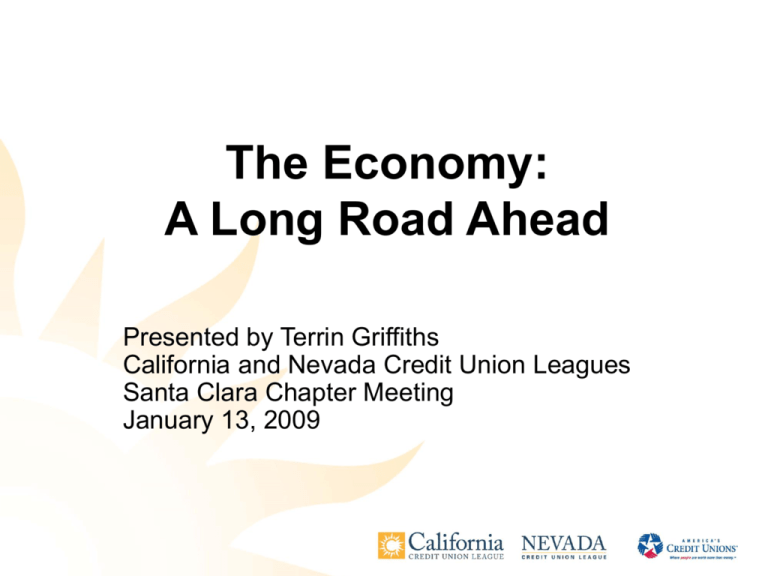
The Economy: A Long Road Ahead Presented by Terrin Griffiths California and Nevada Credit Union Leagues Santa Clara Chapter Meeting January 13, 2009 2008: A “Historic” Year • Prelude to the Crisis – March: Bear Stearns collapses – Spring & Summer: Financial firms hunt for new capital – August: IndyMac seized by FDIC • The Credit Crisis – – – – – – – – – – – – – Fannie Mae and Freddie Mac in conservatorship Lehman bankrupt Merrill Lynch acquired by Bank of America AIG nationalized Goldman Sachs, Morgan Stanley, American Express, and GMAC became bank holding companies Washington Mutual merged into JPMorgan Wachovia acquired by Wells Fargo $700 billion Treasury bailout proposal (TARP) implemented Governments resorted to nationalization, guarantees, bank bailouts, and interest rate cuts Fed lent directly to companies through purchase of commercial paper Dow Jones Industrial Average traded at 7,449 on November 21st Fed interest rate target officially cut to a range of 0% to 0.25% $17.4 billion Treasury loan commitment secured by GM and Chrysler And, at the start of 2009… • • • • • Housing market deflation Substantial job loss Consumer distress Financial market turbulence Government bailouts and stimulus with unknown consequences • Inflationary pressures abating, but this isn’t translating into increased spending U.S. Economic Growth On a downward trend Source: Federal Reserve Bank of St. Louis, *Forecast Sources of Growth Source: Bureau of Economic Analysis Personal Income Growth *projected Source: Bureau of Economic Analysis Nonfarm Payrolls Three month moving average Source: Bureau of Labor Statistics Why is the jobs report unsettling? • 2.6 million jobs were lost in 2008 – Employment fell by 1.9 million over the last four months of 2008 • Average workweek fell to 33.3 hours, indicating more months of substantial payroll cuts. • The number of involuntary part-time workers has risen by 3.4 million over the past 12 months, reaching a total of 8 million. • While the official unemployment rate is 7.2%, counting the marginally attached and underemployed as unemployed results in a rate of 13.5%. In California, many sectors are hemorrhaging Source: Employment Development Department While the growth sectors are showing signs of weakness Source: Employment Development Department California’s unemployment rate is on the rise. Source: Bureau of Labor Statistics San Jose MSA is sharing in the pain. Seasonally Adjusted Source: Beacon Economics Many sectors are shedding jobs Source: Employment Development Department While a mighty few are growing… Source: Employment Development Department Consumer Confidence 160 140 120 100 80 60 December 2008 = 38 40 20 0 80 82 84 86 Source: Conference Board 88 90 92 94 96 98 00 '02 '04 '06 '08 Retail Sales downshift Slowing since mid-2006 Source: Federal Reserve Bank of St. Louis California New Vehicle Registrations Year-to-Date % Change 2008 (as of Sept) vs. 2007 Year-to-Year % Change, by Quarter 2007 Q3 2008 Q4 Q1 Q2 Q3 Northern California -20.9% -6% California -19.3% -11.2% -18.6% -18% -19.1% Source: California New Car Dealers Association -12.7% U.S. Consumer price pressures are easing Source: Bureau of Labor Statistics Crude oil prices have receded *adjusted by CPI (1982-1984=100, SA) Source: Bureau of Labor Statistics and Federal Reserve Bank of St. Louis U.S. Households are more indebted Household Debt Outstanding to Annual Disposable Income 140% 120% 100% 80% 60% 40% Mortgage 20% Consumer 0% 1959Q1 1965Q1 1971Q1 1977Q1 1983Q1 1989Q1 1995Q1 2001Q1 2007Q1 Source: Federal Reserve Flow of Funds, Bureau of Economic Analysis, CUNA Personal saving as a percent of disposable personal income Source: Federal Reserve Bank of St. Louis Housing Market Housing Sales may have stabilized? Source: California Association of Realtors Local Market Variations Region Peak Month Peak Price Median Nov 08 %∆ from Peak Northern California Aug 05 $440,420 $306,940 -30.4% Sacramento Aug 05 $394,450 $184,760 -53.2% Northern Wine Country Jan 06 $645,080 $343,430 -46.8% San Luis Obispo Jun 06 $620,540 $344,230 -44.5% San Francisco Bay May 07 $853,910 $473,510 -44.5% Santa Clara Apr 07 $868,410 $515,000 -40.7% Source: California Association of Realtors Single-Family Home Prices Fall in San Jose MSA Based on transactions involving conforming, conventional mortgages purchased or securitized by Fannie Mae or Freddie Mac. Source: OFHEO Are Homeowners Keeping Up? Percentage of California home mortgages that are past due. Source: Mortgage Bankers Association Difficulties are Mounting Percentage of California home mortgages that are in foreclosure. Source: Mortgage Bankers Association Source: May 2007 Housing Monthly, Ivy Zelman, Credit Suisse, data as of December 2006. Where does this leave us? • • • • • • Housing will struggle. Investment spending will continue to be cautious. Consumers are in retreat. This is a global recession, which is hurting exports. But, it is encouraging a return to saving. All of the above translate into more job loss! As fewer jobs are created, spending power is drying up. • Faced with declining business, employers are further trimming payrolls…completing the cycle! • The stimulus should help, but timing is critical. Economic Outlook for 2009 • Economy should remain anemic given housing and the credit markets. • There is no sector positioned to provide a boost…the hope is that none of the other sectors get worse and housing finally finds its bottom. • Unemployment will rise due to additional job cuts and a lack of payroll growth. • Consumer spending will contract further and will not be the driver it once was as saving becomes a priority. • Housing starts should bottom in 2009, but normalcy will not return for some time due to the recession, financing, and availability of foreclosure properties. • Likely that the government will continue to expand its efforts to help homeowners. • Economic recovery possible in 2010, but it will be accompanied by below-trend growth and elevated unemployment rates. National Economic Forecast 2007 2008 2009 Real GDP (% change, annual average) 2.2% -0.5% -0.3% Mortgage - 30-year Fixed Rate (%) 6.3% 6.0% 5.6% Unemployment Rate (%) 4.6% 5.8% 8.0% CPI (% change) 2.9% 3.9% 0.6% Interest Rate (Federal Funds Rate)(%) 5.0% 2.0% 0.5% Housing Starts (thousands) 1,355 930 720 776 497 393 5,652 4,958 5,161 $218,900 $200,700 $196,900 16.1 13.3 12.0 New Single Family Home Sales (thousands) Existing Home Sales (thousands) Median Existing Home Price ($) Light Vehicle Sales (millions) Sources: Bureau of Economic Analysis; Bureau of Labor Statistics; CUEG; National Association of Realtors; Mortgage Bankers Association; National Association for Business Economists; UCLA Anderson Forecast; U.S. Census Bureau. And in California… • Income and employment will further deteriorate as the housing market bottoms. • A stronger pullback in consumer spending will adversely impact job growth within many regions of the state. • Payroll employment growth will be relatively flat over the next two years with the manufacturing, finance, retail, and housing labor markets enduring the greatest blows. • Unemployment will approach but not exceed 10% and will remain elevated throughout 2010. • Export activity will ease ahead as the global economy softens; import volume could pick up in 2009. • Home price declines will persist into 2009 as areas cope with distressed sales and a hesitant marketplace. • The state’s economy should begin to strengthen in 2010. California Economic Forecast 2007 Nonfarm Employment (thousands) 2008 2009 15,163 15,110 14,866 Unemployment Rate (%) 5.4% 7.1% 9.1% Personal Income (% change) 5.8% 3.0% 3.0% CPI (% change) 3.3% 3.7% 0.8% $562.6 $552.0 $538.3 110,073 65,400 61,600 $558,100 $381,000 $358,000 353,320 395,600 445,000 Taxable Sales (billions of $) Housing Units Permitted Median Existing Single-Family Home Price ($) Existing Home Sales Sources: Bureau of Economic Analysis; Bureau of Labor Statistics; California Association of Realtors; California Department of Finance; National Association of Realtors; UCLA Anderson Forecast; University of the Pacific Forecast; U.S. Census Bureau. And in the San Jose MSA… • The labor market will contract in 2009 with manufacturing, construction, and the information sectors shedding jobs. • Job growth will be absent in 2010. • Unemployment will peak in late 2009 but remain above 8% through 2010. • Venture capital should continue to flow, provided that financial markets stop imploding. • Housing starts will be flat in 2009 with 2010 looking more promising. Credit unions can expect… • Tight margins, deteriorating credit quality, lower lending volumes, and increased competition, particularly for deposits, to be with us for some time. • Loan growth to remain weak into 2009. • Consumer loans and other real estate loans to be dominant sources of delinquency and charge-offs. • Mortgage demand to be steady as consumers re-enter the marketplace into 2009 and turn to their credit unions. • Automobile loan demand to remain weak into 2010. • Delinquencies to accelerate in 2009 while charge-offs level off. • To have members with tarnished credit seeking products to address and rebuild so develop these products now. What are credit unions to do? • Avoid raising fees and loan rates to generate net income; shore up in other areas. • Rising delinquency and loan losses do not necessarily require adjusting lending policies. • These are taxing times for members so let the capital do its job. • Continually communicate your commitment to your members to them. • Tremendous opportunity to gain market share, but lack of earnings will make growth difficult. Credit Union Forecast December 2008 Actual Results 5Yr Avg 2007 Growth rates: Savings growth Loan growth Asset growth Membership growth Quarterly Results/Forecasts 2008:1 2008:2 2008:3 2008:4 Annual Forecasts 2008 2009 5.1% 9.4% 7.1% 2.5% 5.1% 6.5% 6.0% 1.7% 5.0% 0.4% 4.5% 1.1% 1.3% 2.6% 1.3% 1.0% -1.2% 3.7% -0.1% 0.8% 0.5% 1.6% 0.5% 0.2% 6% 8% 6% 3% 10% 6% 10% 2% Liquidity: Loan-to-share ratio** 75.2% 83.4% 79.7% 80.8% 84.8% 85.7% 85.7% 82.6% Asset quality: Delinquency rate Net chargeoff rate* 0.74% 0.52% 0.93% 0.48% 0.96% 0.66% 0.97% 0.74% 1.03% 0.75% 1.20% 0.75% 1.04% 0.73% 1.50% 1.00% Earnings Return on average assets (ROA)** 0.88% 0.65% 0.60% 0.43% 0.34% 0.35% 0.43% 0.50% Capital adequacy: Net worth ratio** 11.4% 11.0% 11.0% 11.1% 11.1% 11.1% 10.6% * End of period annualized rate **End of period ratio 11.2% Questions?

